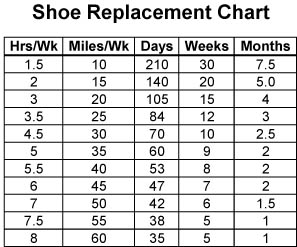
 One of the biggest problems we as runners face is knowing when it is the best time to replace our existing running shoes. Shoes do not come with a magic pop up device, obviously sticking a thermometer in them won’t help and eyeballing them can be very deceiving. Some shoes that look trashed still may have some useful life, and other shoes that look new may be an injury waiting to happen.
One of the biggest problems we as runners face is knowing when it is the best time to replace our existing running shoes. Shoes do not come with a magic pop up device, obviously sticking a thermometer in them won’t help and eyeballing them can be very deceiving. Some shoes that look trashed still may have some useful life, and other shoes that look new may be an injury waiting to happen.
So how do we know when to change shoes? One way is to estimate mileage built up on the shoes. Shoe manufacturers estimate that a typical running shoe costing $100 and above should last between 300 to 400 miles. This is assuming the shoes are only being used for the workout and not being worn casually throughout the day. If they are worn casually the protection the shoe gives a runner during the actual run is severely compromised.
300 to 400 miles sounds like a lot right? Consider this: A runner is training for her first 5K. She starts running 15 to 20 minutes 3 times during the week and a little more on the weekends. She estimates her weekly mileage to be around 10 miles to start and then builds up to let’s say 20 miles in 6 week time period. To make the math easy we can say she averaged 15 miles during that time period for a total of 90 miles. If she stays at the 20 mile per week mark those new shoes will be worn out in less than 5 months from the time she started. Now imagine someone training 30 to 50 miles per week!
 Take a look at the “Shoe Replacement Chart” and notice how quickly the miles add up to 300. It is no wonder worn out shoes are one of the most common causes of running injuries. The miles sneak up on us. If you run based on time instead of miles, or if you use your running shoes for other workouts besides running, you can look at the Hrs/Wk column in the chart to estimate the life of the shoes.
Take a look at the “Shoe Replacement Chart” and notice how quickly the miles add up to 300. It is no wonder worn out shoes are one of the most common causes of running injuries. The miles sneak up on us. If you run based on time instead of miles, or if you use your running shoes for other workouts besides running, you can look at the Hrs/Wk column in the chart to estimate the life of the shoes.
The bottom line is running shoes are disposable. The foam used to cushion the impact of running is light, flexible and fairly resilient, but it compresses with repeated stress. Eventually this foam will compress to the point that it will not be able to protect a runner. The shoes are likely still usable at this point, just not for running. The upper materials rarely will show signs of much wear and the rubber on the sole of the shoe is usually still in really good condition, but the protection technologies in the shoe no longer function the way they were designed. This is the dangerous time of the shoe. We tell ourselves, “I can’t justify another $100+ dollars. I just got these shoes 5 months ago and they still look fine.” Then a few weeks later we are in trouble and wondering if we are going to be able to run that event we already paid for.
It is not wise to say, “I know my shoes are worn out when my knees start hurting.” What?! Why would you knowingly injure yourself? You know you are going to eventually need to replace the shoes anyway so why not get them sooner, before you hurt, as opposed to causing unnecessary trauma to your joints and muscles?
Be on the safe side. A new pair of shoes is not as expensive as a trip to see the Doctor. If the worst thing that happens is you purchase an extra pair of shoes now and then, no big deal. You will use them. The alternative is you don’t make the purchase and wind up with injuries that could have been avoided.
